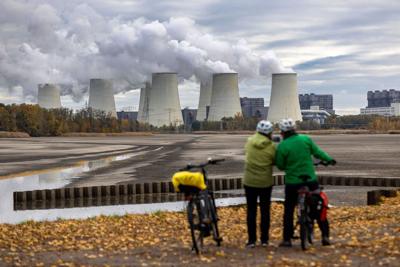(CNN) � No pollution is good for anyone’s health, but a new study found that scientists may have significantly underestimated just how deadly pollution from coal-fired plants can be. It also shows how tighter regulations can work.
The study, in the journal Science, found that exposure to fine particulate air pollution from coal-fired plants is associated with a mortality risk that is 2.1 times greater than that of particle pollution from other sources.
Particle pollution, also known as particulate matter, is the mix of solid and liquid droplets floating in the air, the says. It can come in the form of dirt, dust, soot or smoke. Coal- and natural gas-fired power plants create it, as do cars, agriculture, unpaved roads, construction sites and wildfires.
, one of the smallest forms of particle pollution, is � 1/20th of a width of a human hair � that it can travel past your body’s Instead of being carried out when you exhale, it can get stuck in your lungs or go into your bloodstream.
The particles cause irritation and inflammation and may lead to respiratory problems and chronic Exposure cancer, stroke or heart attack; it could also aggravate asthma, and it has with a higher risk of .
Between 1999 and 2020, 460,000 deaths among people who got health coverage through Medicare were attributable to coal-fired plants, the new study showed. The mortality impact was higher in the of the US, which sees more coal-related pollution and has higher population density.
As regulations got stricter over the years, deaths from this kind of pollution decreased substantially by 2020, the researchers found. The vast majority of excess deaths due to coal-related particle pollution in the study were between 1999 and 2007, when the US was averaging more than 43,000 excess deaths per year. That’s who died in traffic crashes in 2021. The coal particle pollution-related deaths represented nearly a quarter of all PM2.5-related deaths among Medicare enrollees before 2009.
After 2007, though, excess deaths declined “substantially,� the study says, to 1,600 in 2020.
The researchers studied emissions data from 480 coal-fired plants in the US and almost two decades worth of Medicare data. they modeled where the wind carried emitted by these plants, which can lead to the formation of other sulfur oxides that react with other compounds in the atmosphere that form particle pollution.
An editorial that was published alongside the study noted a limitation of the research: It didn’t measure PM2.5 directly and did not include the effect of another kind of pollution, nitrogen oxide, which combines with emissions of volatile organic compounds from other sources to form ozone, which can also cause health problems. But the editorial’s authors, Dr. Robert Mendelsohn and Seung Min Kim, scientists at Yale and Columbia, are complimentary of the work.
Study co-author Dr. Francesca Dominici, a professor of biostatistics at the Harvard T.H. Chan School of Public Health, said that previous studies � “including mine, by the way� � underestimated how damaging pollution from coal plants could be because they used a measure of fine particulate matter from EPA air quality monitors that was good but limited.
The EPA monitors measure fine particulate matter from all sources, and it is difficult to disentangle how much pollution came from coal-fired power plants alone, Dominici said. She hopes the new study will prompt policymakers to quickly adopt clean energy alternatives
“We need to move away from coal pollution. There is really no reason to have it,� Dominici said. “The fact that coal pollution is so much more awful at creating fine particulate matter than other sources is something that should be understood and acted on all around the world, not just in the US.�
While coal use in the US is now much lower than in the 1990s, its use globally is predicted to increase, the study said. In other words, the world could still see a high number of excess deaths for many years to come.
Dr. Laura Kate Bender, a at the American Lung Association who leads its Healthy Air Campaign, said the new study is very much in line with other research that has shown how dangerous pollution from coal-fired plants is.
“This just adds to the enormous weight of the evidence about not just the burden of PM2.5 on mortality from coal-fired power plants, but also the impacts of cleaning it up,� said Bender, who did not work on the new research.
The study showed that emission reductions brought about by regulation under the 1990 Clean Air Act amendments made a difference, Bender said.
Predicted excess mortality from coal-fired plant emissions in 2020 was just 3% of what it was in 1999, the study showed.
“Environmental protections work,� Bender said, but it is important to note that not everyone has shared equally in those benefits.
Due to decades of residential segregation, the American Lung Association says, Black people tend to live where there is a greater exposure to air pollution. and an EPA review of pollution research have shown that people of color, especially Black people, live with significantly higher levels of particulate matter pollution. That causes a higher risk of premature death for people who are Black, especially compared with White people, even when income is factored in.
The American Lung Association has been advocating for the EPA to adopt a number of stronger measures to limit particulate matter pollution even further. Studies show that people’s health is jeopardized at an even lower level than the national pollution level .
“The science clearly shows that tighter limits will be more protective,� Bender said.
The-CNN-Wire
� & © 2023 Cable News Network, Inc., a Warner Bros. Discovery Company. All rights reserved.














